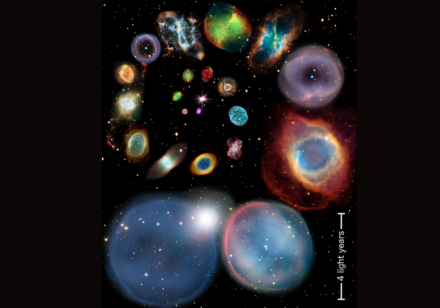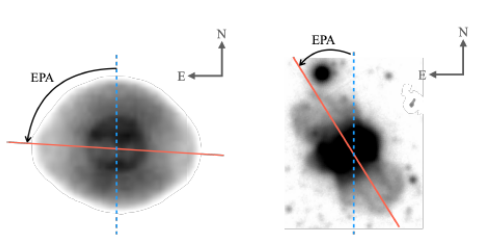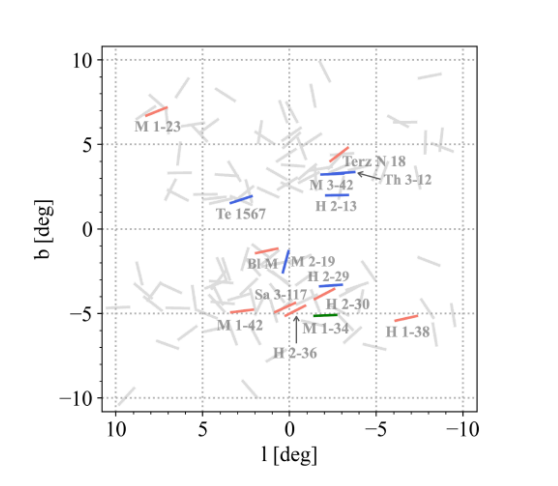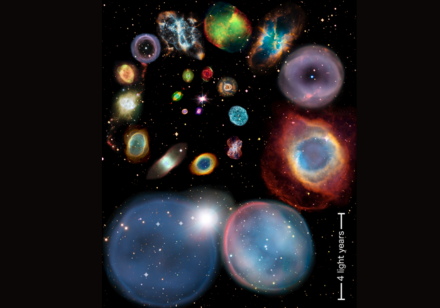13 Jul 2023
HKU and Manchester University Astronomers come closer to finding answers about mysterious alignment of ghost stars

Image credit: ESA/Hubble and NASA, ESO, NOAO/AURA/NSF from an idea by the corresponding author and Ivan Bojičić and rendered by Ivan Bojičić with input from David Frew and the author
Scientists who discovered evidence of an unusual and mysterious alignment of planetary nebulae in the central bulge of our galaxy ten years ago, have now obtained a much stronger result and have also now discovered what might cause it.
Astronomers from The University of Hong Kong and the University of Manchester have studied a specific group of stars found near the centre of our galaxy, in particular those hosting planetary nebulae.
When stars, such as the sun, are at the end of their life, they expel material into space, which creates a striking structure, usually in the shape of an hourglass, or butterfly. These ‘ghosts’ are called planetary nebulae.
Despite the planetary nebulae being unrelated, having different characteristics and properties, formed at different times, and located in different places, the study found a high degree of certainty that many of their shapes align in the sky in a similar manner. They are aligned almost parallel to the Galactic plane (our Milky Way) - but the reason was unknown and the signal diluted. Until now.
Led by HKU's MPhil student Shuyu TAN, the astronomers used additional data collected over the last decade to confirm that the alignment is exclusively present in planetary nebulae with close binary stellar companions - a star orbiting the main star at the center of the PNe in an orbit closer than Mercury's orbit around our Sun.
 |  |
| Measurement of the equatorial position angle (EPA). The orientation axis measured from the projected 2-D image of a bulge PN was determined visually and the axis that best represents the long symmetry of each PN. The left panel shows a typical elliptical PN M 1-20 with a morphology of "Ems" and an EPA of 87° according to its major axis from HST observations. The right panel shows bipolar M 1-34 from our sample with a "Bps" morphology and an EPA of 31° measured from the VLT observation. Image credits: Shuyu Tan, The University of Hong Kong. | The bulge distribution of measured GPAs for all PNe in the sample. The grey symbols are for the general sample while those PNe with confirmed binary central stars are blue vectors and those with high adfs (that are taken as a reliable proxy for PNe hosting short-period binaries) are pink vectors. M 1-34, suspected of hosting a short period binary, is plotted with a green vector. The usual name of each PNe are plotted under each blue, pink or green vector. Image credits: Shuyu Tan, The University of Hong Kong. |
As the corresponding author of the paper and the Director of HKU Laboratory for Space Research, Professor Quentin PARKER, who is also a frequent and long-term visitor to Manchester University, suggests that these stellar companions could be the cause of this mysterious alignment.
“The significance in this research lies in the fact that we now know that the alignment is solely observed in this very specific subset of planetary nebulae, those that host close binary central stars. This indicates the presence of a constant and controlled process that has influenced these objects over billions of years and vast distances. It is a remarkable discovery.” says Professor Parker.
“Planetary nebulae offer us a window into the heart of our galaxy and this insight deepens our understanding of the dynamics and evolution of the Milky Way’s bulge region.” he adds.

A now iconic collage showing 22 individual well-known PNe, artistically arranged in a spiral pattern by order of approximate physical size. Each nebula’s size is calculated from the SB-r statistical distance scale from Frew et al. (2016). It can be applied to PNe exhibiting the entire range of surface brightness, morphology and size. The largest PNe have a surface brightness about a hundred thousand times fainter than the smallest and can reach up to 3 pc across. General image credit: ESA/Hubble and NASA, ESO, NOAO/AURA/NSF from an idea by the corresponding author and Ivan Bojičić and rendered by Ivan Bojičić with input from David Frew and the author.
Professor Albert ZIJLSTRA, a senior collaborator from Manchester University, said, “This finding pushes us one step closer to understanding this remarkable alignment.”
“The formation of stars in the bulge of our galaxy is a complex process that involves various factors such as gravity, turbulence, magnetic fields and interactions between particles. Until now, we have had a lack of evidence for which of these mechanisms could be causing this process to happen and generating this alignment.” he adds.
The researchers investigated 136 confirmed planetary nebulae in the galaxy bulge – the thickest section of our Milky Way composed of stars, gas and dust - using the European Southern Observatory Very Large Telescope (a main mirror diameter of 8metres). They also re-examined and re-measured 40 of these from the original study using images from the high-resolution Hubble Space Telescope.
They discovered that the alignment was found exclusively in planetary nebulae that host close binary central stars and that are also almost exclusively bipolars – planetary nebulae with a symmetrical shape. This suggests that the alignment is potentially linked to the initial separation of the binary components at the time of the star’s birth.
The researchers also suggest that the binary stars may have been formed in the presence of a strong magnetic field, which could influence the axis of these planetary nebulae during their formation.
Although further studies are needed to fully understand the mechanisms behind the alignment, the findings provide important evidence for a persistent, organised process that has influenced the formation and evolution of these planetary nebulae over billions of years.
Click here to visit the website of HKU Laboratory for Space Research.
Click here to view the journal paper.







